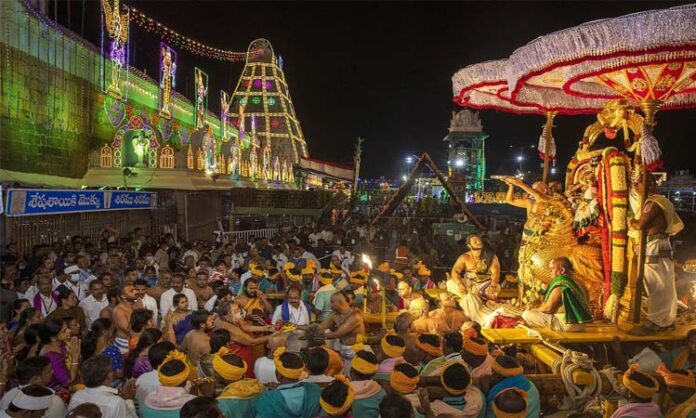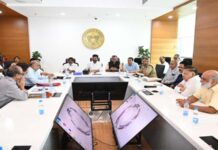VAHANA SEVAS
The Brahmotsavams are believed to be the most colourful religious events in the country as the processional deity of Lord Venkateswara,popularly known as Sri Malayappa Swamy takes a celestial ride every day and every evening on various vahanams, which will be a visual treat to watch.
Among these vahanams Lord Malayappa is flanked by His two consorts Sri Devi and Bhu Devi on Pedda Sesha, Mutyapu Pandiri, Sarvabhupala, Kalpavruksha, Swarna Ratham, Rathotsavam and Bangaru Tiruchi.
While He goes all alone on Chinnasesha, Simha, Mohini, Garuda,Hanumantha, Suryaprabha, Chandraprabha, Aswa vahanams.
Pedda Sesha Vahanam:
After Dhwajarohanam, the processional deity of Lord Sri Venkateswara,popularly known as Sri Malayappa Swamy commences His celestial ride in the series of 16 vahana sevas during these nine days with Pedda Sesha Vahanam, the seven hooded giant Serpent King “Adisesha”.
Chinna Sesha Vahanam:
On the second day morning, the Lord is seated on Vasuki – the five hooded Serpent God as His vehicle. In Bhagavat Gita Lord Sri Krishna says He is Vasuki among the serpents. This signifies that how important is Chinna Sesha Vahanam.
Hamsa Vahanam:
On the second day evening the Lord is again taken out on a celestial procession on Hamsa (Swan)vahanam. Hamsa means ‘pure’ and the swan is believed to have a high intellectual capability and can distinguish good from bad.
Simha Vahanam:
On the third day morning the Lord is taken out in a procession on Simha carrier. Simha – the Lion is a symbol of royalty and power. Lord assumes the form of half man and half lion in his Narasimha Avathara. Lord Sri Krishna says in Bhagavat Gita that He is the Lion among the animals.
Muthyapu Pandiri Vahanam:
On the evening of the third day, the Lord is again taken out in procession along with His consorts Sri Devi and Bhu Devi in a palanquin decorated with a canopy of pearls. Pearl is said to be a symbol of purity and royalty.
Kalpa Vruksha Vahanam:
On the fourth day of the festival, the Lord is taken out in a colourful procession on the dazzling and finely decked Kalpa Vruksha –the divine tree as His vehicle along with Sridevi and Bhudevi signifying that He is the giver of boons.
Sarva Bhoopala Vahanam:
On the fourth day evening the Lord is again taken out for a procession on a vehicle called Sarva Bhoopala Vahanam along with His two consorts signifying that He is the Universal Lord of Lords.
Mohini Avatharam:
On the fifth day morning the Lord is taken out for a procession on a finely decorated Palanquin in the attire of Mohini Avatharam – the Universal Celestial Beauty, along with Sri Krishna Swamy on another Palanquin.
Garuda Vahanam:
On the fifth day evening Lord Sri Venkateswara is taken out in a grand procession on specially decorated, mighty golden Garuda vehicle-His most favourite vehicle usually witnessed by tens of thousands of devotees.
Hanumantha Vahanam:
On the sixth day morning the Lord is taken out on a procession with Lord Hanuman as His vehicle. Hanuman is worshiped as he is the personification of the most trusted and self less service and a role model to present day humanity.
Swarna Rathotsavam:
On the sixth day evening the Lord is taken out first for a celestial ride on Swarnarathotsavam, where He is accompanied by His two consorts Sri Devi and Bhu Devi. It is also known as Ratharanga Dolotsavam.
Gaja Vahanam
On the sixth day night the Lord is mounted on Gaja Vahana which reminds us the Gajendra Moksham story of Bhagavat Gita where in the Lord gives salvation to the Elephant King by killing the crocodile.
Surya Prabha Vahanam:
On the seventh day morning the Lord Venkateswara is taken out in a procession with Sun God driving the Chariot. Purusha Sooktha describes Sun is born from the eyes of Lord Srimannarayana. Lord Vishnu also takes the form of Lord Sri Surya Narayana Murthy while taking celestial ride on Suryaprabha vahanam.
Chandra Prabha Vahanam:
On the seventh evening the Lord is again taken out for a solo ride on Chandra Prabha Vahanam which signifies pleasantness. While Sun is born from the eyes of Lord Maha Vishnu, Moon is born from His mind. Moon is the commander of mind and is a symbol of cool and pleasantness.
Rathostavam:
On the penultimate day, the Lord Venkateswara is taken out on a procession along with His consorts seated on a fully decorated gigantic wooden Chariot pulled by the devotees chanting Govinda Nama along four mada streets.
Ashwa Vahanam:
On the eighth evening the Lord is again taken out on a procession with Aswa (Horse) as his vehicle symbolizing the forthcoming incarnation of Kalki Avathara.
Chakra Snanam:
On the ninth morning, the last day of the Brahmostavam, special abhishekam (Avabhruda Snanam) will be held to Sri Malayappa Swmay and His consorts Sri Devi and Bhu Devi on the banks of Swamy Pushkarini located opposite Varahaswami temple along with Sudarshana Chakra (Disc weapon of the Lord). Later the anthropomorphic form of Lord is immersed in the sacred waters of Swamy Pushkarini.
Dwajaavarohanam:
On the last evening, the Garuda flag will be lowered as a mark of the successful completion of the Brahmostavam. It is performed in the Dhwajastamba mandapa amidst the chanting of vedic hymns and thanking the deities of all the worlds.
Besides these Vahana Sevas, on the second, third and fourth days,Snapana Tirumanjanam is performed to the utsava deities in Ranganayakula Mandapam between 1pm and 3pm in a spectacular manner.














